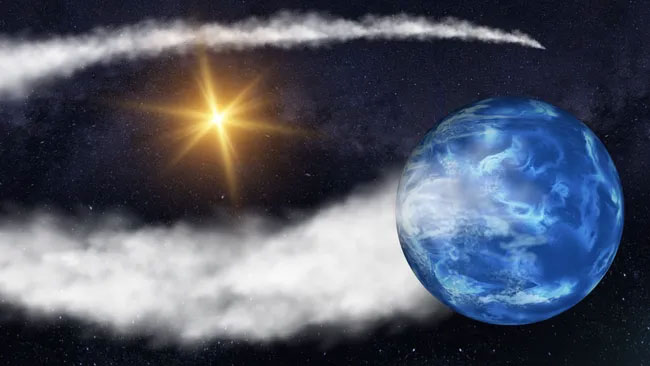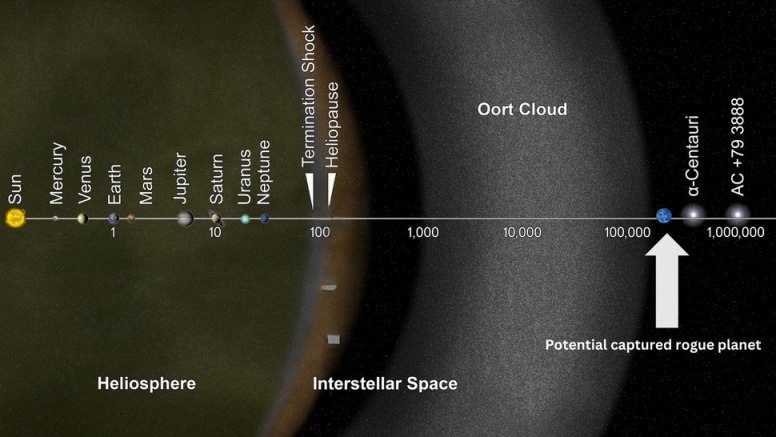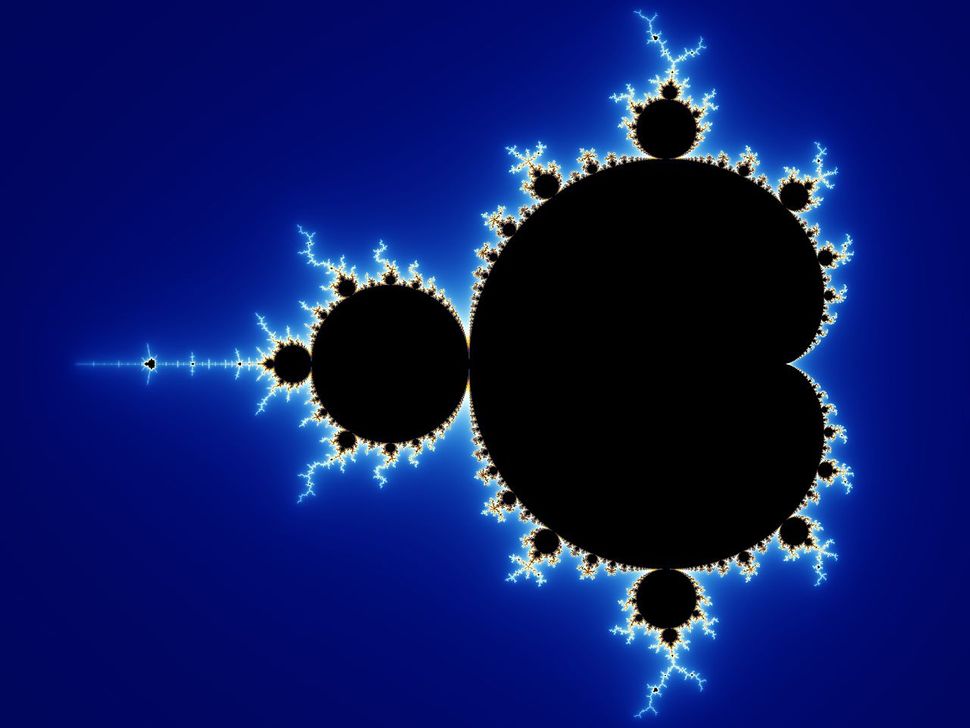The Sun scoops up rogue planets as they fly by. The Sun is capable of capturing both small planets and Jupiter-sized gas giants that stray too close; our star then keeps them at the edge of the solar system.
The solar system is capable of exchanging its valuable rogue planets with those captured by its neighboring star system Alpha Centauri. And new research suggests that escaped worlds accepted by the solar system could orbit its outskirts for billions of years before approaching the sun and potentially wreaking havoc on the inner solar system.
Scientists have long speculated that the solar system may capture passing objects such as comets and asteroids, collecting them outside the Oort cloud, which is believed to be a spherical shell of trillions of icy bodies at the outer edges of the solar system.

Illustration of a rogue planet orbiting the solar system at a great distance
But the new study shows that this “capture region” extends far beyond the Oort cloud, which is about two light-years from Earth (about 126,000 times the distance between Earth and the sun). The work also shows that our planetary system is capable of pulling in bodies much larger than comets or asteroids.
“We found that when objects are captured in our solar system, the distance at which they can be captured is much greater than previously thought,” Edward A. Belbruno, study author and professor of mathematics at Yeshiva University, told Space.com. “We found that the objects that can be captured are about 3.81 light-years away, which is close to the next star system, the Alpha Centauri system.”
While our Solar System would be unable to capture an object with a mass equal to or greater than the Sun, since this would interfere with the Sun’s gravitational influence, it is capable of collecting rogue planets with masses up to that of Jupiter, which is a thousand times less massive than the Sun.

A diagram showing the distance at which our solar system could collect rogue planets. NASA/JPL-Caltech/Robert Lea
“This is a very interesting result,” Belbruno continued.
Rogue planets are worlds that have been ejected from their planetary systems. This can happen when a passing star disrupts the gravitational stability of the planetary system or simply due to natural upheavals in a young star system.
The Milky Way is estimated to be populated by a huge number of free-floating rogue planets. Our galaxy may contain up to a quadrillion (10 followed by 14 zeros) rogue planets that have been ejected from their home systems and are wandering the Milky Way as cosmic orphans.
While much research has focused on how rogue planets might be ejected, less research has focused on the possibility that these celestial orphans might find a new home.
The duo of scientists behind the study, including former NASA expert James Green, discovered something surprising about this capture of rogue planets. Green realized that there are actually two gravitationally stable points, or “Lagrange points,” at which entanglement can occur.
“You have two regions, little holes where things can fall into the solar system at these two Lagrange points,” Belbruno said. “One points toward the Galactic Center, one points away from it.”

The illustration shows a cold orphan planet, covered in ice due to the absence of a parent star and emitting no light of its own. NASA’s Goddard Space Flight Center
A mathematics professor with a passion for celestial mechanics explained that when rogue planets do enter the solar system through these openings, they will first begin to move very slowly around our sun, staying at a distance of about 3.81 light years for about 100 million years. After this period, they will begin to spiral inward, a process that can take billions of years.
Belbruno explained that one interesting factor he and Greene discovered about this migration is that the new addition to the solar system will orbit in a pattern called a “fractal curve.” This is a mathematical curve with a shape that follows the same pattern of irregularities as it gets larger. A famous example of this is the Mandelbrot set. “You get these really cool-looking curves, especially as the object gets closer and closer to the capture site,” Belbruno explained.
Belbruno explained that to capture a rogue planet, the Sun would need to be traveling at a relatively low speed of a few hundred miles per hour. That’s very fast by Earth standards, but it’s a cosmic speed, given that runaway planetary-mass objects have been detected traveling at speeds in excess of 1.2 million miles per hour (1.9 million kilometers per hour).
The low speeds of these captured rogue planets mean that there may be a veritable reservoir of such objects orbiting the Sun for billions of years (at distances of up to 3.81 light years).

Illustration of the Mandelbrot set, perhaps the most famous fractal. Wolfgang Beyer
And what happens if a captured rogue planet makes its way into the solar system? Well, Belbruno said that the effect would depend on the size and mass of that planet.
“Let’s say this world was the size of Jupiter and it flew into the solar system,” he said. “A Jupiter-sized object flying into our solar system would, in some sense, cause a dramatic shift in orbit. That would immediately affect the dynamics of the Earth around the sun, and that would certainly affect life on this planet.”
“It is possible that some planets in the solar system may get out of control.”
Of course, a rogue planet may never make it to the inner solar system. As mentioned above, orbiting the Sun at a distance of 3.81 light years would bring a captured rogue planet very close to Alpha Centauri, which could trap its own rogues and keep them at bay.
“Our solar system’s gravity is close to Alpha Centauri’s gravity, so that would mean that Alpha Centauri’s capture zone is very close to our own sun’s,” Belbruno said. “The two systems completely overlap in terms of gravitational influence, and that means that it would be very, very natural for objects to move back and forth.”
The scientists’ work is currently based on mathematical modeling, with Belbruno noting that since rogue planets emit little light, detecting one beyond the Oort cloud would be extremely difficult.
One helpful factor in the search is that Belbruno and Green pinpointed two capture sites, and these Lagrange points are a natural place to start hunting for adopted orphan planets. Such a search may currently be beyond the capabilities of telescope technology, although the James Webb Space Telescope (JWST) could probably detect the thermal emissions of such a world in infrared light.
“Many objects could be in holding patterns there, sort of spiraling around the sun,” Belbruno concluded. “If they come in, they can’t get out – even if they entered the solar system 4 billion years ago. It’s certainly possible that there are rogue planets out there that have been captured.




